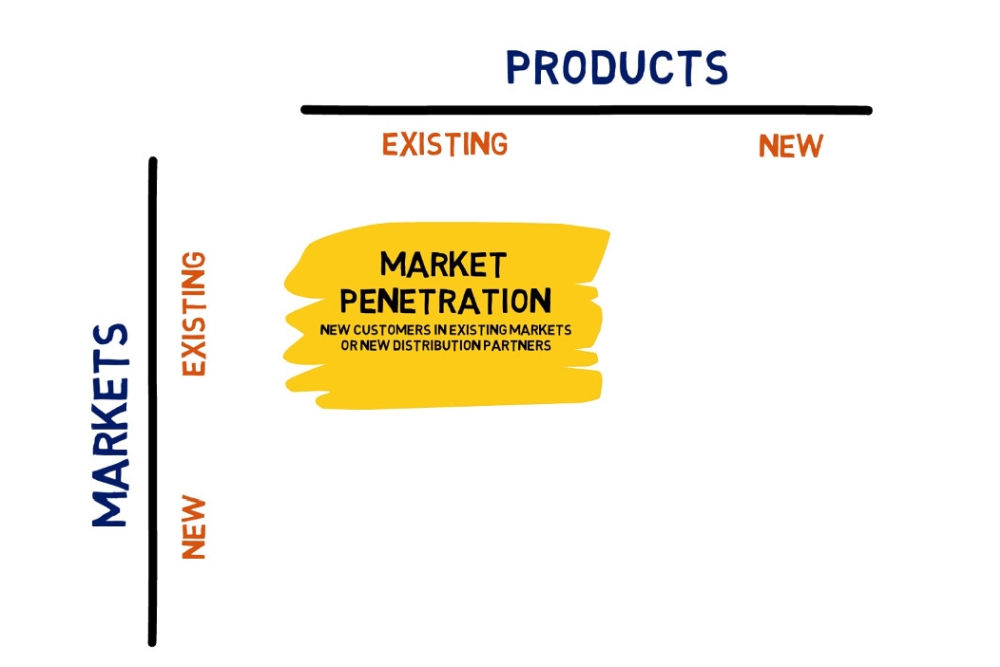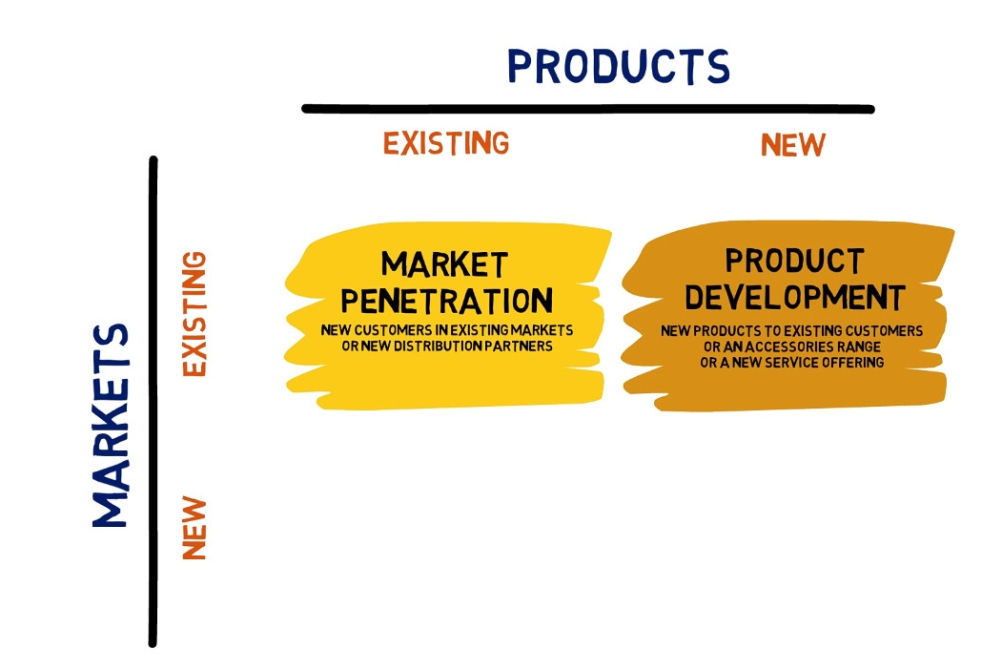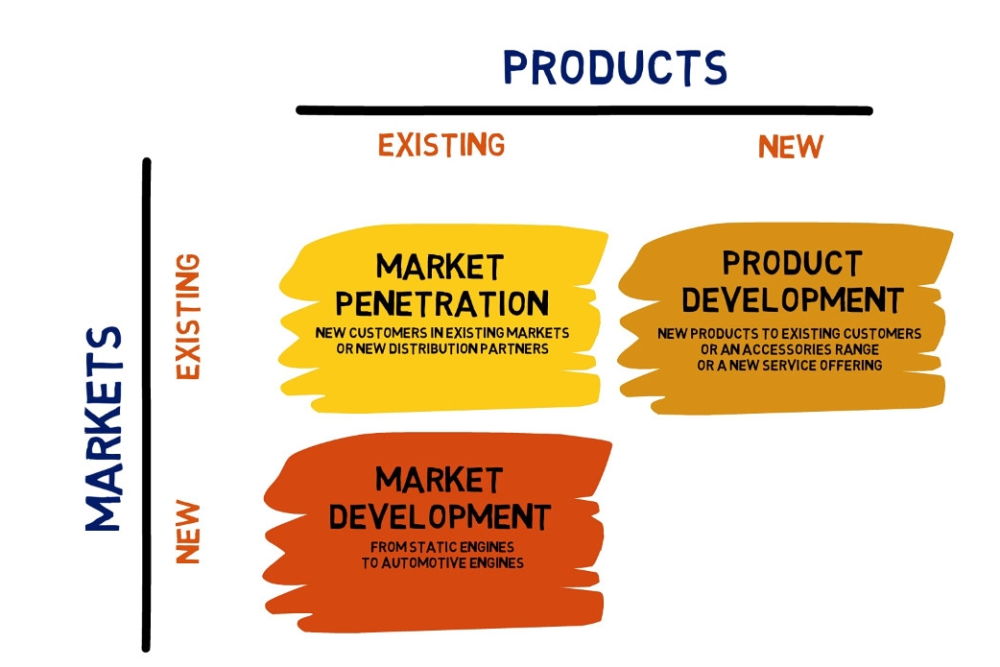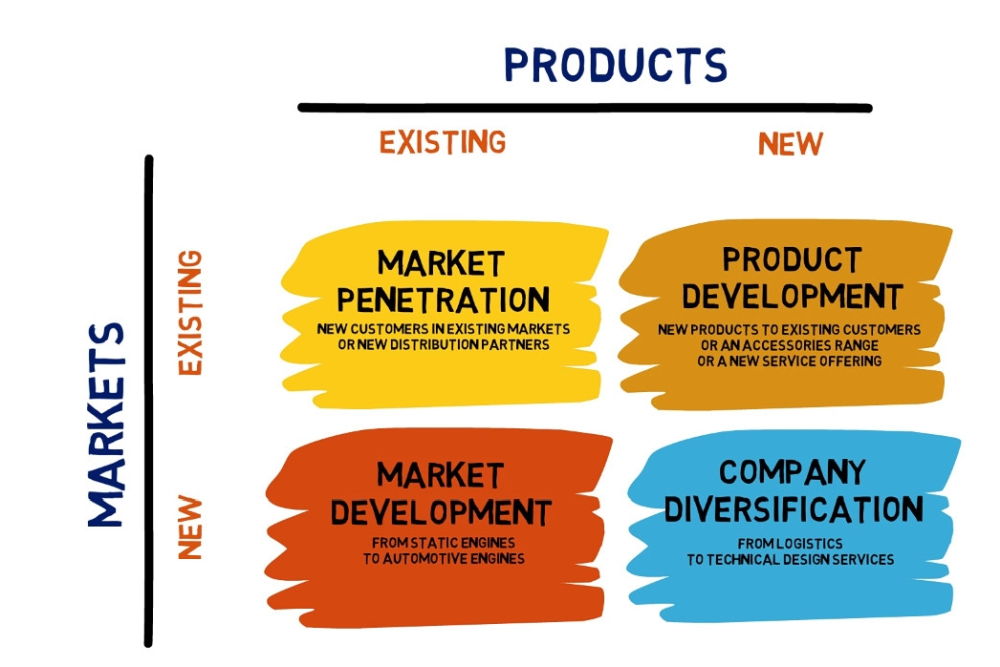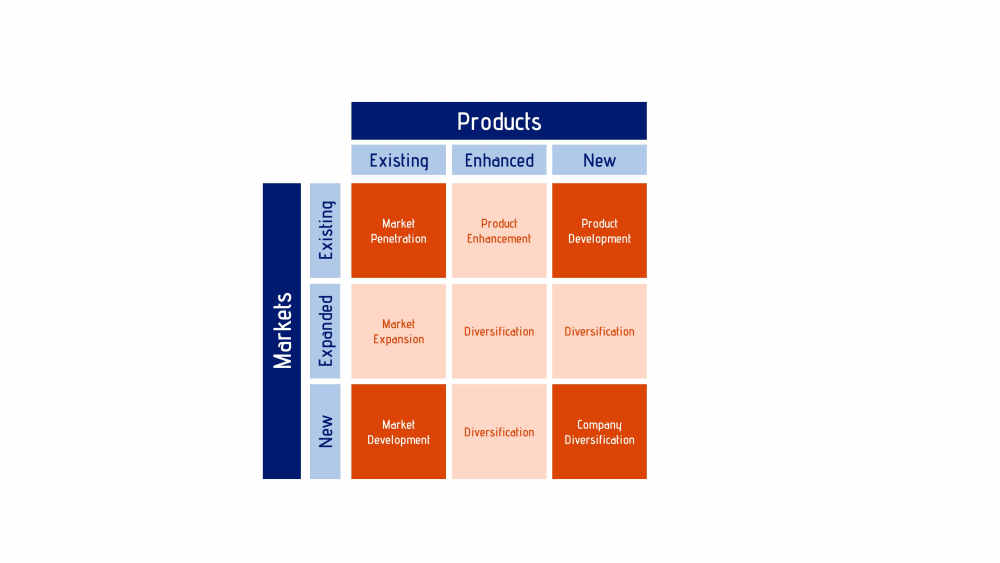The Ansoff Matrix – deciding your growth strategy
The Ansoff Matrix is an old business model that survives to this day because it still helps you develop a growth plan for your business. It won’t magically reveal an option you’d never thought of before but it will help you understand the difficulties you’ll face with different growth options.
Contents
- Ansoff 1: Market Penetration
- Ansoff 2: Product Development
- Ansoff 3: Market Development
- Ansoff 4: Company Diversification
- Ansoff Matrix examples
- The Nine-Box Ansoff Matrix
What is the Ansoff Matrix?
Imagine a matrix with products across the top axis and markets down the side. Each axis is divided into existing and new. This gives you four boxes which represent your four growth strategies.
Ansoff 1: Market Penetration
Selling your existing products to your existing markets is called a Market Penetration strategy. It gets a bad rap compared to the other growth strategies because it’s not so revolutionary. It seems a bit stale. Sceptics ask “If you’re selling the same products and you’re targeting the same markets, why are you going to grow?”
That’s a poor way to view the market penetration strategy.
Before you dismiss market penetration as a growth strategy, get an honest and accurate assessment of your market share. If you’ve got less than 10%, market penetration should be the first growth strategy you look at, not the last.
Consider its advantages. You don’t have to develop any new products/services. You may need to improve your current offering but that’s far simpler than developing something entirely new.
You also know the market. Not only do you understand the customers, there’s a good chance that a lot of them will already be familiar with your brand. You already have the foundations you need to build a bigger market share.
Market penetration is a great growth strategy for SMEs that have grown organically without much in the way of marketing support. They know from their existing customers that their product/service is satisfactory; it may even be good or exceptional. What they don’t know is how to grab more of the market. That’s why they need marketing support.
When devising a new strategy for market penetration, remember all four of the 4P’s (product, price, place and promotion). Growth isn’t just about a new promotional campaign. Growth might come from improving the product or its customer care wrapper – that’s ‘product’ too. Growth could be generated by new pricing or offers. Or growth might come from a new distribution strategy, putting the product/service in more places from which customers could buy it. And yes, you could grow through new promotional techniques, especially if you haven’t used marketing before.
Ansoff 2: Product Development
If you want to develop a new product/service for your existing customers, that’s a Product Development growth strategy. Imagine you’re a software company producing a time-management app. Adding an accounting app to your range and selling it to your existing customer base would be product development.
The advantage of this option is that you have a ready-made market in which you’ve already established your credibility. You’ve broken down most of the barriers to entry.
Your problems come if you try to develop something that is not a logical extension of what you already do. If a lot of doctors buy your time management software, they might think twice if you try to sell them medical supplies.
We’ve worked for a company that sold control panels to the manufacturers of industrial generators. The company developed fuel cleaning and emissions reduction systems because those same manufacturers needed the technology. That’s a perfect example of a product development growth strategy.
Some product development strategies can look very strange. Years before I became a respectable marketer (if there is such a thing), I was a journalist for Computer Shopper magazine. Shopper was by far the biggest magazine in this market at the time (this is back in the 1990s when people still bought magazines). It had the biggest circulation, it had the biggest advertising revenue and, when it peaked at almost 1,000 pages an issue, it was the physically the biggest magazine too.
So it would seem strange for the publisher of such a successful magazine to launch another magazine into the same market. But that’s exactly what Dennis Publishing did. The reasoning may have looked illogical but it was perfectly sound. Even though the new magazine took readership away from Computer Shopper (and you’d better believe we screamed about it), the publisher gained market share when the two titles were viewed together.
Ansoff 3: Market Development
The Market Development route envisages you selling what you already produce to new markets. Engine manufacturers like Caterpillar are a great example. They sell engines to truck manufacturers, boatbuilders and generator suppliers. They even supply engines to their own competitors in the construction equipment market.
The advantage of the market development strategy is that it extracts more revenue from existing products. R&D is expensive, whatever the technology. If you can sell it successfully to several markets, you extract a better return for your investment.
The challenge in Market Development is understanding the technical and commercial nature of the new market. The engines Caterpillar sell to truck manufacturers, for example, are subject to different emissions legislation than the static engines in generators. Which is very bizarre when you think about it because they’re all pumping their fumes into the same atmosphere.
Ansoff 4: Company Diversification
The most ambitious growth strategy is Company Diversification, where you try to develop a new product to sell into a new market.
Company diversification is advantageous for businesses that already dominate their existing and potential markets and can’t see a new product that could be developed viably for those markets.
Company diversification is the riskiest of all the strategies. It’s very difficult to establish credibility in a market that doesn’t know you for a product/service you’ve only just developed. That’s why most companies diversify by acquisition. They skip the product development phase by buying the expertise of an existing company. At the same time, they acquire whatever credibility and brand recognition the subsidiary had built.
Ansoff Matrix examples
The Virgin Group is so diverse it provides examples of every type of growth strategy. You might look at the launch of Virgin Megastores as an example of a market penetration strategy. It gave the original music production business a new and more direct route to its ultimate customers. You might also look at it as a Market Development strategy.
Continuing the Virgin Group example, having successfully targeted holiday-makers with Virgin Atlantic, it showed a product development strategy when it launched Virgin Holidays; new product, same market.
Maintaining the focus on the Virgin Group, you might also say that its activities in space represent market development with Virgin Galactic addressing the well-heeled consumer market and Virgin Orbit addressing the commercial satellite market.
Soft drinks companies are great examples of businesses that expand by diversification. A company like Coca-Cola, for example, sells its drinks into practically every country in the world and it’s doubtful you could teach it anything about distribution strategies. Furthermore, the world has a limited appetite (pun entirely intended) for more soft drinks. We’re already flooded with them (okay, I’ll stop the puns now).
So Coca-Cola expands by diversification. In 2019 it bought Costa Coffee, for example. Costa may still be a drinks company but the consumer who sits in a coffeehouse or grabs a drive-through coffee is very different to the shopper who buys a can of Coke.
The other reason why the Coca-Cola example is illustrative is that shows company diversification needs deep pockets. Whether you acquire an existing company or develop a new product for a new market, you have to be ready for a significant investment.
By happy coincidence, this market also provides us with our final Virgin Group example. Virgin diversified when it launched Virgin Cola. It hadn’t produced soft drinks before and it didn’t operate in the fast moving consumer goods market (FMCG). Virgin Cola was not a success. That should be pause for thought for the rest of us.
What is the Nine-Box Ansoff Matrix?
Since the original Ansoff Matrix was published in 1957 it has been “improved” by adding enhanced products and expanded markets in between the new and existing positions.
It’s our advice to ignore this improvement. The Ansoff Matrix isn’t a precise planning tool. It was never meant to be. It’s beauty is its simplicity and its familiarity. When you make it more complex you rob it of its prime assets and get no benefit in return.
So, that’s the Ansoff Matrix. It’s an old model but it’s still useful because, as we said at the start, it opens your eyes to the challenges that face any growth plans you have.

